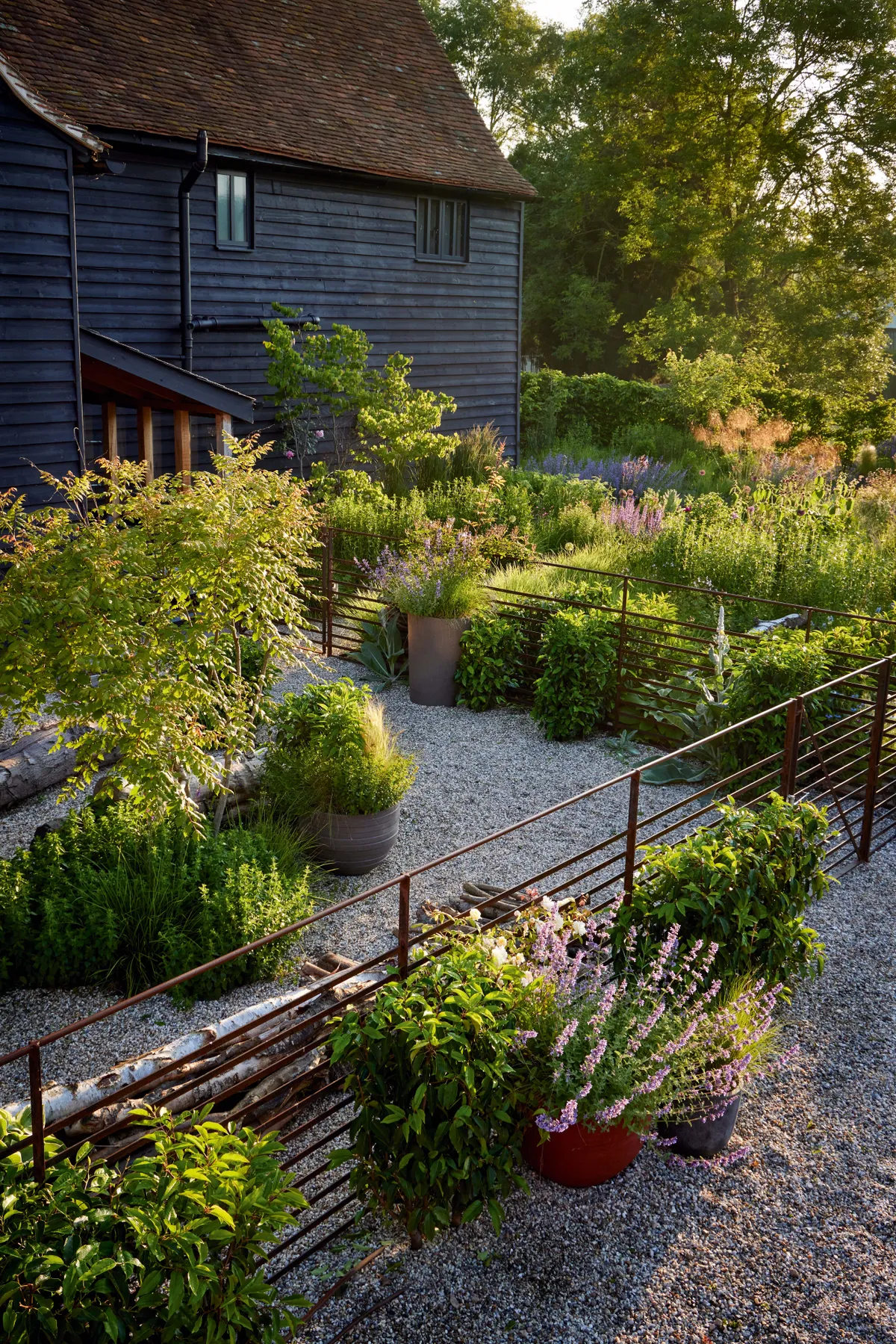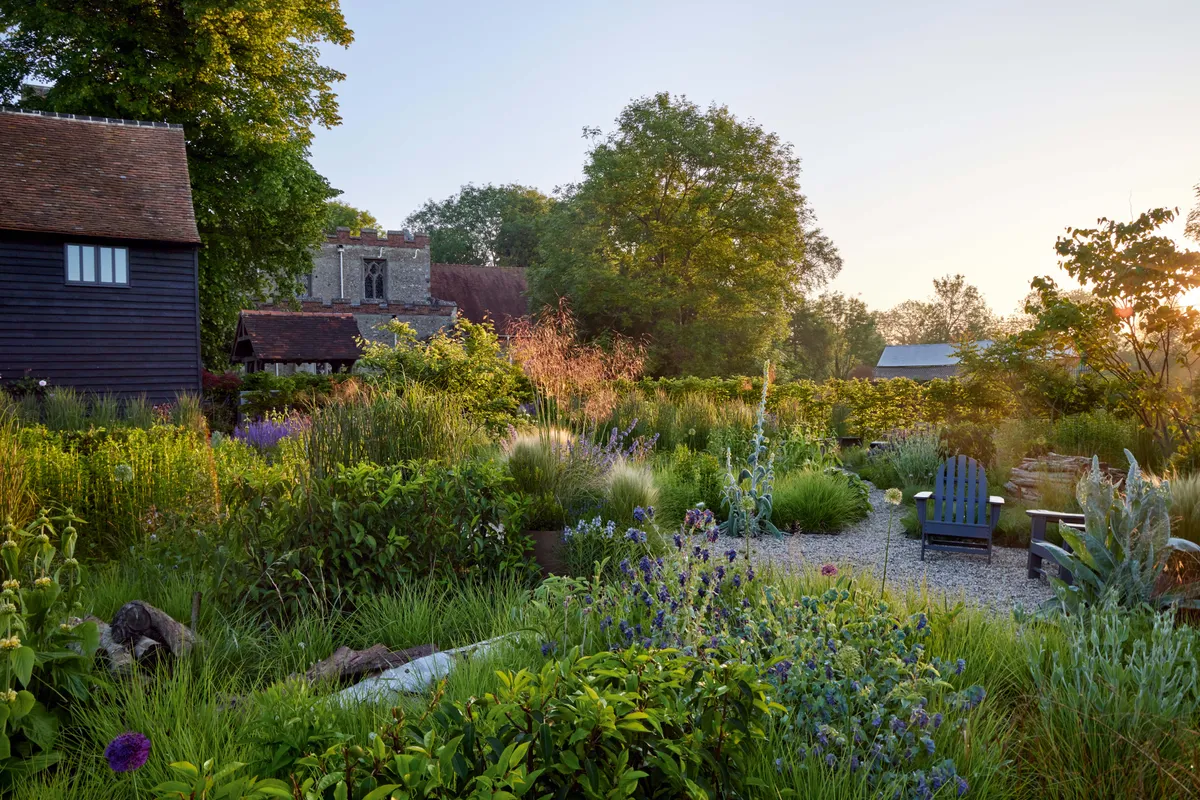When landscape architect Stefano Marinaz first arrived at this barn conversion next to an ancient village church, he found an extensive lawn and patio, and disproportionately large parking space that was completely out of context with the site. Luckily, the owners weren’t wedded to the lawn and were happy to embrace Stefano’s ideas for the area. “My portfolio appealed to them but they couldn’t imagine my gardens in their space,” says Stefano. “It wasn’t until I visited to explain our vision that their new garden was born.”

Rather than look to the imposing 18th-century barn for inspiration, Stefano took his cue from the surrounding countryside. “The idea was to create a structure using woody plants and hedges, and add grasses and perennials for texture and colour,” he explains. His design is based around interconnecting informal paths that help to divide the garden and lead to three organically shaped open areas – one for sunbathing, another focused around a firepit and the third, a sunny spot where the owners enjoy their morning coffee.

Stefano designed the bespoke furniture for this fire pit area close to the barn, which is surrounded by shades of green and subtle hues of blue in the form of Salvia x sylvestris ‘Dear Anya’, growing in pots, and Nepeta racemosa ‘Walker’s Low’ mingling with the paler shades of Nigella damascena and Gillenia trifoliata. Close to the black-painted barn is a pop of pink from Rosa rugosa while white Rosa Claire Austin (=‘Ausprior’) is beginning to climb the black wall.

The former car-parking area has been transformed into a stylish courtyard filled with pots from Atelier Vierkant holding plants including Stipa tenuissima, with its constantly moving stems trailing Geranium Rozanne (= ‘Gerwat’); and stiff-stemmed Limonium platyphyllum. The area is bordered by bespoke rust-coloured, mild steel estate fencing that takes its inspiration from the horizontal feather-edge cladding of the barn.

Two gravel paths merge at a secluded seating area cocooned by tall grasses, including Stipa gigantea and Calamagrostis x acutiflora ‘Karl Foerster’. In early summer, colour comes from dark-purple Cerinthe major ‘Purpurascens’ and the delicate, star-shaped, pale-blue flowers of Amsonia hubrichtii, while the emerging silvery spikes of Verbascum bombyciferum will add bright-yellow tones later in summer. Within the planting, piles of logs create habitats for insects. Beyond the garden stands the old
village church and churchyard, which features ancient lime trees that Stefano has ‘borrowed’ for the garden’s outlook.
What is a plant community and how to create one
• Stefano has ensured a long season of interest by using a wide range of different plant groups – bulbs, annuals, grasses, perennials, shrubs and trees – that work together as a community. For this to be successful, it’s important to choose plants that have similar growth rates and habits so there is balance within the plant community. “Combining plants with different seasonal growth is also useful,” says Stefano, “as this allows plants to flower and go dormant while others start showing new growth. And by doing this they hide the foliage of the plants going dormant.”

The key to success is ensuring around 30-40 per cent of the plants used are grasses, as this will help blend the mix of perennials and bulbs in a naturalistic way. This grass matrix should comprise clump-forming grasses that are ideally no taller than around 30-50cm, to avoid overwhelming the tall perennials. Grasses and perennials with narrow leaves are useful, so emerging plants don’t get shaded out.
Plant the perennials in groups of 10-12 minimum, and in long, weavy layouts rather than blocks. Self-seeders such as nigella, honesty and California poppies will help fill any gaps in newly planted schemes, rather than leaving them open to weeds.
In this garden, Stefano has used the low-growing, clump-forming grass Sesleria autumnalis, with a mix of annuals and perennials including Nigella damascena, Gillenia trifoliata, Amsonia hubrichtii, Nepeta racemosa ‘Walker’s Low’ and Salvia x sylvestris ‘Dear Anya’.
USEFUL INFORMATION Find out more about Stefano’s work at stefanomarinaz.com. Join Stefano for a tour of Church Barn on 13 September and 18 November. Follow Stefano on Instagram (@stefano.marinaz)
